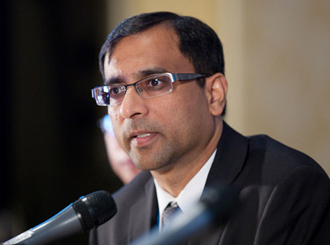Sujeet Kumar's Envia Doubles Car Battery Capacity
By wchung | 13 Dec, 2025
By using novel electrode materials Sujeet Kumar has doubled the charge storage capacity of batteries that his company hopes will become standard in electric cars.
By using novel electrode materials Sujeet Kumar has doubled the charge storage capacity of batteries that his company hopes will become standard in electric cars.
Kumar is president and chief technology officer of Envia Systems Inc, a startup funded by GM and the U.S. government’s Advanced Research Projects Agency for Energy (ARPA-E). Envia is basing its technology on a material developed by DOE’s Argonne National Lab which has a structure that boosts the storage capacity of one of the battery’s two electrodes.
The same technology is being considered by GM and its battery supplier LG Chem in batteries for the next generation of the Chevy Volt. Envia has achieved higher energy densities by making its own modifications to the original Argonne technology.
A problem that existed with Argonne’s formulation was the tendency of the manganese in its electrode to migrate out and dissolve in the battery electrolyte, degrading storage capacity with each charge cycle. Envia researchers added trace elements to the electrode material and coatings around the electrode to keep the manganese in place.
Envia also changed the material of the opposite electrode from the usual graphite to silicon which allows far greater energy densities. The problem with silicon is its tendency to swell and crack with each charge cycle, drastically limiting its useful life. Envia used a porous form of silicon that can survive the expansion and contraction and mixed the silicon with carbon fiber and graphite to provide a path for electrons to take through the material and fill the gaps created when the silicon cracks. The company also modified the electrolyte to keep it from degrading at the high voltage levels inside the battery cell. Envia tested 1,500 different combinations of electrodes and electrolyte in tiny cells.
Once it settled on its current formulation, it built cells of the size typically fitted into electric cars. Each Envia cell weighs one kilogram and stores 400 watt-hours, a big improvement over current lithium-ion batteries that store between 120 and 250 watt-hours per kilogram.
But before Envia can release its design for use in electric cars, it must get it to retain 80% of its original storage capacity after 1,000 charge cycles. At the moment its cells are reduced to 72% of original capacity after only 400 charges. Achieving the goal will require more improvements to the electrodes. Envia will also have to get its cell to pass more safety tests, though it has already passed the crucial nail puncture test.
One big advantage of Envia’s battery is its use of materials that can be made with existing battery equipment. Rather than making the batteries itself, Envia plans to license the technology to battery manufacturers or create joint ventures.
Once its technology has been optimized, it can be used either to cut the cost of battery packs from the current $7,000-$10,000 level or, alternatively, double the range of elecric cars. Currently the best ones get about 70-90 miles on a charge.
Envia’s technology was highlighted at the end of February at the Department of Energy’s annual ARPA-E summit in Washington, D.C. to demonstrate the Department’s progress in green energy technology.
Sujeet Kumar was the original CEO of Envia when he co-founded it in July 2007. Before that Kumar was a senior scientist at Greatbatch where he led development and scale-up of nano-crystalline silver vanadium oxide cathode material for high rate lithium batteries. Kumar was the principal scientist at Nanogram Devices Corporation (NDC), where he developed battery components used in implantable medical devices. As a project manager at Nanogram he led several energy storage and photonics device projects. Kumar earned a PhD in materials science from the University of Rochester. He is an inventor with over 40 patents.

By using novel electrode materials Sujeet Kumar has doubled the charge storage capacity of batteries that his company hopes will become standard in electric cars.
Asian American Success Stories
- The 130 Most Inspiring Asian Americans of All Time
- 12 Most Brilliant Asian Americans
- Greatest Asian American War Heroes
- Asian American Digital Pioneers
- New Asian American Imagemakers
- Asian American Innovators
- The 20 Most Inspiring Asian Sports Stars
- 5 Most Daring Asian Americans
- Surprising Superstars
- TV’s Hottest Asians
- 100 Greatest Asian American Entrepreneurs
- Asian American Wonder Women
- Greatest Asian American Rags-to-Riches Stories
- Notable Asian American Professionals

